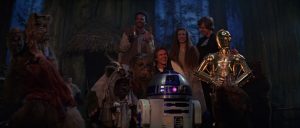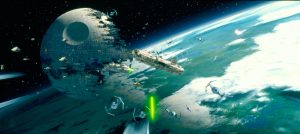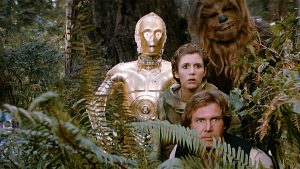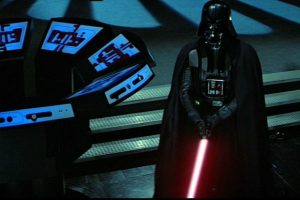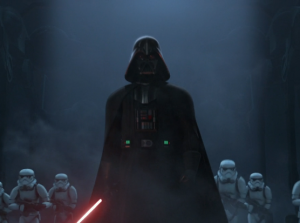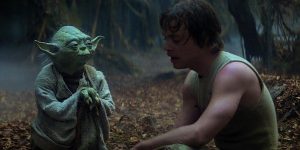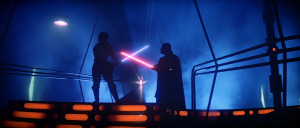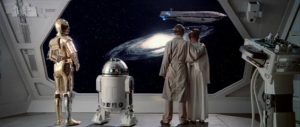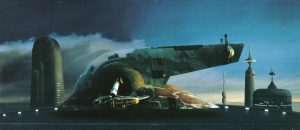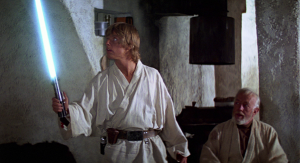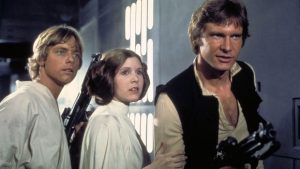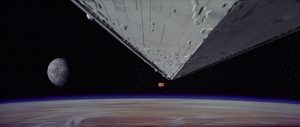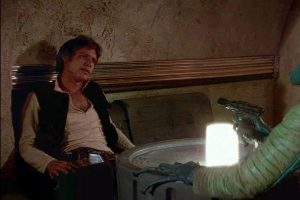We are officially in the last leg of the long journey to Star Wars: The Rise Of Skywalker, which means that the mighty Skywalker Saga, a story spanning forty years across films, books, comics, cartoons and video games is finally coming to a close – which in turn means that it’s time to reflect on that nine-part saga and take a good long look at the films that predate and inform Rise Of Skywalker‘s epic conclusion.
To do that, we’re going to have to discuss spoilers for each of the eight films in the Saga, so…SPOILERS AHEAD.
Star Wars: The Force Awakens
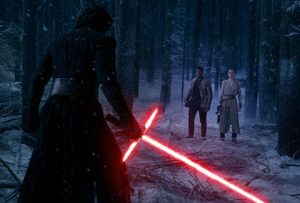
A lot gets made of the fact that, when designing the story structure of The Force Awakens, director J.J. Abrams used the first Star Wars movie as a template instead of trying to make sense of George Lucas’ fabulous script draft which would have explored the backstory of the mysterious, microbiotic Whills, yet another previously unknown species which apparently live inside Force-sensitive beings. Tell me, dear reader: would you rather be forced to sit through another trilogy about midi-chlorian biology, or something that actually focuses on…oh, I don’t know, an actual story? Doesn’t mean Abrams couldn’t have gone for something a little more fresh, but it’s a Star Wars tradition at this point to start out basic.
And let’s not pretend like A New Hope isn’t an awesome movie to try and repeat. The Force Awakens, thankfully, is a good copy of a very good movie. Could be worse: it could have been a clone of Attack Of The Clones, for instance!
There are several crucial differences between Lucas’ original film, and Abrams’ wildly successful remake, which is one of the highest-grossing movies of all time. Abrams’ Star Wars film, the first produced under the Disney banner, is more committed to having a diverse cast representing many different demographics. The story has a strong thematic core, and does break away from A New Hope at the very end to set up an intriguing cliffhanger and a fascinating conflict between our protagonist and her sworn enemy. And the film overall has a sense of self-awareness that allows for some fun bits of meta-humor: not quite as much as The Last Jedi, but still quite good.

Rey (Daisy Ridley) is not Luke Skywalker. Though she may live a nearly identical life on a nearly identical planet, she is in many ways his opposite. For instance, Rey is compelled to eventual action by her desire to do good, not by any personal motivation – in fact, if she had her way, she would be flying back to the dusty sand-pit of Jakku as fast as possible to await her parents’ return. Ridley does a very good job of selling Rey’s resilience, practicality and the feeling that she truly is a nobody. Rey clearly has a strong connection to Skywalkers of old, and it remains to be seen whether The Rise Of Skywalker will reveal a missing link between her family and theirs, but she is at first reluctant to accept any of the duties bestowed upon her. She doesn’t have any princesses to save, any helpful Kenobi to guide her (actually, there is a Kenobi-lookalike living not far away on Jakku, but he gets murdered by the First Order within the first five minutes), or any known reason to get involved besides wanting to help the Rebellion in their time to need. For her archenemy, Kylo Ren (Adam Driver), it’s a personal affront to his strong sense of heritage to see a “nobody” daring to intrude on the Skywalker Saga.
Kylo Ren is not Darth Vader, and the First Order is not the Empire. Whereas the Empire was modeled strongly after the Nazi regime, the First Order are their modern counterparts, neo-Nazis. Kylo Ren is no tragic hero in the style of Anakin Skywalker, no matter how much he yearns to wear the helm of Vader and declare himself a Sith Lord: Kylo, with his idiotic accouterments of darkness and unintelligible muffled voice, is Vader’s cheap knock-off – an elitist, privileged white boy who runs away from home only to be brainwashed by cultists and madmen. As for the First Order, we’ve never actually had a clear idea of where they came from or how they established power in the galaxy, but their acolytes are obviously under the impression that they’re following in the footsteps of history’s forgotten heroes, as you do when you’re a neo-Nazi. And yes, there were many ways to get this point across that didn’t involve the First Order somehow having all the same Imperial technology and agendas, all the way down to having Stormtroopers who are just as bad at firing weapons.
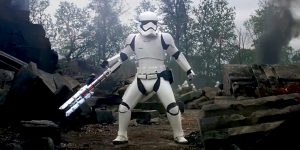
Speaking of Stormtroopers, the character of FN-2187 a.k.a. “Finn” (John Boyega) has no equal in the original trilogy. As a First Order foot-soldier sickened by the horrors of warfare and struggling between his fear of the Order and his instinct to run, Finn represents everybody trapped in a dark place, looking for a way to escape. But after he does achieve his freedom, the film really never has anything more to do with his character, and so slowly but surely he becomes comic relief, with even his few distinguishing features watered down or made into jokes: oops, no, he was never really a great stormtrooper after all – turns out, he was a janitor. Whoops, he got his hands on a lightsaber for a moment there – but he’ll be stuck with a random blaster-gun from now on. After a while, it’s simply pathetic to watch as he gets dumbed down, tripped up, or otherwise undermined by a script that never seems to remember it’s dealing with a literal Stormtrooper.
The original characters are not the same characters we knew. We see Luke Skywalker (Mark Hamill) only very briefly, but exposition allows us to understand that after the events of Return Of The Jedi, the legendary Skywalker went into hiding after his new Jedi temple produced the villainous Kylo Ren: much of the plot of The Force Awakens revolves around trying to track down the last Jedi and enlist him to fight the First Order. Leia Organa (Carrie Fisher), on the other hand, has aged gracefully into her responsibilities as commander of the Resistance, a group of battle-worn veterans who apparently only got to enjoy a decade or two of peace before going back onto the battlefield. Even C-3PO (Anthony Daniels) is hardly recognizable anymore with his new red arm, while R2-D2 (Kenny Baker) has gone into low-power mode, awaiting the return of Skywalker (the latter development, besides being a necessary plot-point, also seems contrived to keep our attention on the new droid, BB-8). But the most startling change has come over Han Solo (Harrison Ford), whom we last cracking jokes and wooing Leia after the Battle of Endor. Han in The Force Awakens is no hero, but instead a worn-out pirate back to his old ways: he’s fled from his duties as a parent, having given up all hope on his wayward son, Kylo Ren (whose given-name is actually Ben Solo). It’s fun and charming to see Han seeking adventure in the great unknown with his usual rogue’s gallery of weird-looking alien villains, but it’s not long before he’s reluctantly drawn back into the fate of the Skywalker family, as he’s called upon to track down Kylo Ren and bring him home. The relationship that he develops with fellow pilot Rey has led to much speculation that the two are father and daughter, but that theory doesn’t make much sense to me (though Abrams plays his cards just right, so that every theory about Rey’s parentage seems like it could have a seed of truth): I think Han saw Rey as the child he never had, the child Kylo could have been if he had been a better father. When Han eventually comes face-to-face with his son, Kylo seems almost to hesitate, to waver, asking aloud for guidance and help. There are many theories about what exactly occurs in this moment, and what was going through both characters’ heads as they both realized what needed to happen. But whoever it was that ignited the blade, somehow Kylo Ren’s lightsaber ended up embedded in Han Solo’s chest. Most likely it was Kylo with the guidance of his Sith master Snoke (voiced by Andy Serkis), but maybe it was Han acting quickly and selflessly to ensure that his son would be kept alive by the First Order; maybe that would ease the burden of patricide off of Kylo’s shoulders; maybe that would preserve a small glimmer of light within his dark, corrupted soul. Whatever you choose to believe, I think we can all agree that in this case, Han never even had a chance to shoot first.
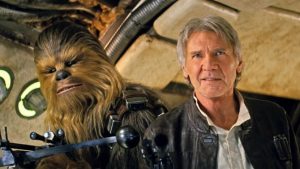
He also never gets a proper burial, as Starkiller Base explodes shortly after his death, meaning that his body is merely stardust in the vacuum of space. Maybe that’s how he would have wanted it. It’s certainly how Harrison Ford wanted it: he had been waiting for that moment since 1983.
Starkiller Base is not…no, actually, Starkiller is basically just the Death Star, isn’t it? Except bigger and covered in trees for whatever reason. Is it an actual planet that was converted into a gigantic weapons-system for the First Order? If not, and it was man-made, why would you waste time terraforming the place – especially since you know the entire planet will get blown up in a couple of minutes by two or three fighter pilots? Beyond being annoying redundant, the reveal that Starkiller is 5.5 times the size of the Death Star is honestly insulting to the pilots and brave Rebels who lost their lives disabling that weapon back when it was considered the biggest thing in the franchise.
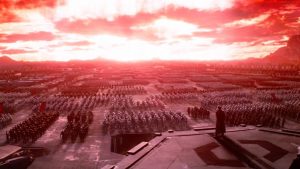
Pretty much everything else is precisely what you think it is: Poe Dameron (Oscar Isaac) is a more morally-pure Han Solo (though even that is apparently set to change, with the character possibly meeting some unsavory rogues from his own past in The Rise Of Skywalker). The Resistance is virtually no different than the Rebellion of yesteryear – they’ve got the same tech, the same military commanders, the same call-signals.
The Force Awakens is not A New Hope.
It’s the same hope, with a different name, and a slightly different story, told from a new perspective and through the eyes of a modern, diverse cast of characters. It’s, admittedly, not the most groundbreaking installment in the saga’s history. But this same hope is what’s been keeping the Star Wars story going strong for over forty years, and it hasn’t failed yet: it’s the hope that rebellions are built on, the hope that lights a fire that will restore the Republic, or ignite Resistance, or burn the First Order down, or do pretty much anything you want it to – it’s all the classic charm of Lucasfilm, mixed in with a little sprinkle of Disney magic, and I must say, I quite enjoy the taste.
Movie Rating: 7.9/10
